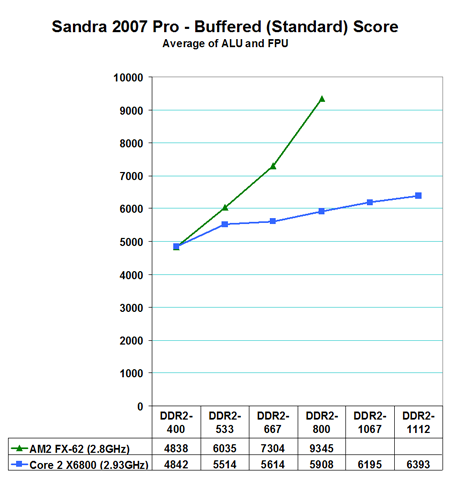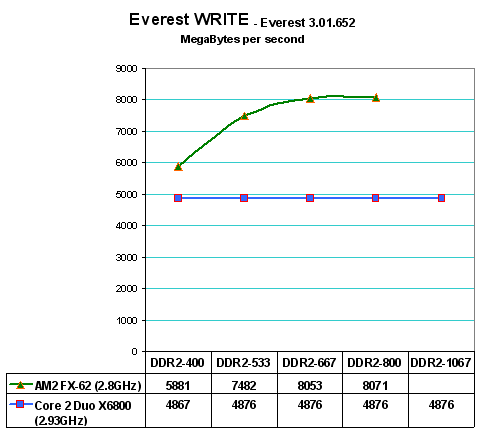Memory Bandwidth and Scaling
Everyone should already know that memory bandwidth improves with increases in memory speed and reductions in memory timings. To better understand the behavior of AM2 and Core 2 Duo memory bandwidth we used SiSoft Sandra 2007 Professional to provide a closer look at memory bandwidth scaling.

The most widely reported Sandra score is the Standard or Buffered memory score. This benchmark takes into account the buffering schemes like MMX, SSE, SSE2, SSE3, and other buffering tools that are used to improve memory performance. As you can clearly see in the Buffered result the AM2 on-chip memory controller holds a huge lead in bandwidth over Core 2 Duo. At DDR2-800 the AM2 lead in memory bandwidth is over 40%.
As we have been saying for years, however, the Buffered benchmark does not correlate well with real performance in games on the same computer. For that reason, our memory bandwidth tests have always included an UNBuffered Sandra memory score. The UNBuffered result turns off the buffering schemes, and we have found the results correlate well with real-world performance.

The Intel Core 2 Duo and AMD AM2 behave quite differently in UNBuferred tests. In these results AM2 and Core2 Duo are very close in memory bandwidth - much closer than in Standard tests. Core 2 Duo shows wider bandwidth below DDR2-800, but this will likely change when the AM2 controller matures and supports values below 3 in memory timings as the Core 2 Duo currently supports.
The Sandra memory score is really made up of both read and write operations. By taking a closer look at the Read and Write components we can get a clearer picture of how the two memory controllers operate. Everest from Lavalys provides benchmarking tools that can individually measure Read and Write operations.

The READ results are particularly interesting, since you can see that the READ component of Core 2 Duo performance is much larger than the WRITE results on Core 2 Duo. This is the result of the intelligent read-aheads in memory which Intel has used to lower the apparent latency of memory on the Core 2 Duo platform. Actual READ performance on Core 2 Duo now looks almost the same as AM2 to DDR2-533. AM2 starts pulling away in READ at DDR2-677 and has a slightly steeper increase slope as memory speed increases. The increases in READ speed in Core 2 Duo are a result of the intelligent read-aheads in memory. Performance without this feature would show Core 2 Duo much slower in READ operations than AM2.

This is most clearly illustrated by looking at Everest Write scores. Memory read-ahead does not help when you are writing memory, so core 2 Duo exhibits much lower WRITE performance than AM2 as we would expect. This means if all else were equal (and it isn't) the AM2 would perform much better in Memory Write tasks. Surprisingly the WRITE component of Core 2 Duo appears a straight line just below 5000 MB/s. AM2 starts at 5900 at DDR2-400 and WRITE rises to around 8000MB/s at DDR2-667. Write then appears to level off, with higher memory speeds having little to no impact on AM2 WRITE performance.
Everyone should already know that memory bandwidth improves with increases in memory speed and reductions in memory timings. To better understand the behavior of AM2 and Core 2 Duo memory bandwidth we used SiSoft Sandra 2007 Professional to provide a closer look at memory bandwidth scaling.

The most widely reported Sandra score is the Standard or Buffered memory score. This benchmark takes into account the buffering schemes like MMX, SSE, SSE2, SSE3, and other buffering tools that are used to improve memory performance. As you can clearly see in the Buffered result the AM2 on-chip memory controller holds a huge lead in bandwidth over Core 2 Duo. At DDR2-800 the AM2 lead in memory bandwidth is over 40%.
As we have been saying for years, however, the Buffered benchmark does not correlate well with real performance in games on the same computer. For that reason, our memory bandwidth tests have always included an UNBuffered Sandra memory score. The UNBuffered result turns off the buffering schemes, and we have found the results correlate well with real-world performance.

The Intel Core 2 Duo and AMD AM2 behave quite differently in UNBuferred tests. In these results AM2 and Core2 Duo are very close in memory bandwidth - much closer than in Standard tests. Core 2 Duo shows wider bandwidth below DDR2-800, but this will likely change when the AM2 controller matures and supports values below 3 in memory timings as the Core 2 Duo currently supports.
The Sandra memory score is really made up of both read and write operations. By taking a closer look at the Read and Write components we can get a clearer picture of how the two memory controllers operate. Everest from Lavalys provides benchmarking tools that can individually measure Read and Write operations.

The READ results are particularly interesting, since you can see that the READ component of Core 2 Duo performance is much larger than the WRITE results on Core 2 Duo. This is the result of the intelligent read-aheads in memory which Intel has used to lower the apparent latency of memory on the Core 2 Duo platform. Actual READ performance on Core 2 Duo now looks almost the same as AM2 to DDR2-533. AM2 starts pulling away in READ at DDR2-677 and has a slightly steeper increase slope as memory speed increases. The increases in READ speed in Core 2 Duo are a result of the intelligent read-aheads in memory. Performance without this feature would show Core 2 Duo much slower in READ operations than AM2.

This is most clearly illustrated by looking at Everest Write scores. Memory read-ahead does not help when you are writing memory, so core 2 Duo exhibits much lower WRITE performance than AM2 as we would expect. This means if all else were equal (and it isn't) the AM2 would perform much better in Memory Write tasks. Surprisingly the WRITE component of Core 2 Duo appears a straight line just below 5000 MB/s. AM2 starts at 5900 at DDR2-400 and WRITE rises to around 8000MB/s at DDR2-667. Write then appears to level off, with higher memory speeds having little to no impact on AM2 WRITE performance.










118 Comments
View All Comments
TonyB - Tuesday, July 25, 2006 - link
so ive been hearing a lot of people use this argument, "oh competition is good, i can get a so-and-so cpu now for xyz price!!". what an incredible value!cant you bring that a notch higher and say, "dang, Intel just whooped AMD, i'm going to purchase an amd K6-2 400mhz cpu now for $5" yes! horray for competition! what an incredible value only $5!
at what point does reality set in that you're investing in obsolete technology? or does the old rationale, "i dont want the fastest, this old crap is good enough for me" still apply.
OcHungry - Wednesday, July 26, 2006 - link
You waited 4 years to say that "crap" about AMD's bargain value? but please dont tell us about your 4 years venture in finding a better way to exhust your P4 hot air.very nice.
Calin - Wednesday, July 26, 2006 - link
Unfortunately, the current production processors don't reach that low a value (the AM2 semprons have a price of around $70+, and the Socket A semprons have a price of around $50). You might want to invest in new obsolete technology (with a longer warranty), or you might want to invest in old obsolete technology (or in old current technology, see refurbs).As long as your performance needs are reached, you could be certain to a degree that a failure in your computer could be repaired/replaced in short time, you are ok to go with Pentium MMX or so processors. Anyway, finding SDR RAM for your K6-2 might not be so easy (and SDR DIMMs were a new memory standard then). Good luck finding enough SIMMs to put the memory at 128MB
BPB - Tuesday, July 25, 2006 - link
How about an article spending $200 on both the CPU and video card ($400 total) and then look at what various motherboard and memory combos get me. You could spend $100 to $250 on motherboards and show me what I get, with memory hopefully being the same for the Intel and AMD systems. That's really the bottom line for myself and many, many others. Many if not most of us set a price range for CPU, video card, and memory and then go from there. Either that or simple overall cost is set. I know you give us buying guides where you spend X amount on systems, but I don't think you show us the power each system gets.photoguy99 - Tuesday, July 25, 2006 - link
They already have those articles - They periodically release CPU and Graphics card guides that analyze the bang for the buck at different budgets.BPB - Tuesday, July 25, 2006 - link
I know they do that, but I don't think I've seen both "here's what $1000 gets for an AMD/Intel system" and "here's how fast each system is". That's what I'd like to see. I know how much individual parts cost and how fast they are in and of themselves, but put it all together and show me systems and compare those systems. If they've done that in the past I've missed it. But the past no longer matters, so I'd love to see one that's current as of today's new prices.Calin - Wednesday, July 26, 2006 - link
The computer price guides did just that - taking a budget of $$$ or $$$$ and building systems. There was the budger guide, gamer guide and "all out" guide (this last one had price ranges at $2000+)bob661 - Tuesday, July 25, 2006 - link
What was the purpose of this article? Was there something that was left out of the tons of earlier benchmarks from various websites?bob661 - Tuesday, July 25, 2006 - link
Thanks guys. I don't remember seeing info about memory either.rjm55 - Tuesday, July 25, 2006 - link
There were a lot of things that I hadn't seen anywhere else. No one I have read shows that Conroe is lower in Bandwidth than either AM2 or Netburst. I find that surprising looking at Conroe's big performance lead. This is also the first time I've seen AM2/Conroe compared clock-to-clock in the same configuration using the same memory/settings - and at 2.93GHz. The new graphs for memory speeds show directions and provide more info that bar charts. Suggest you use them more in other reviews.